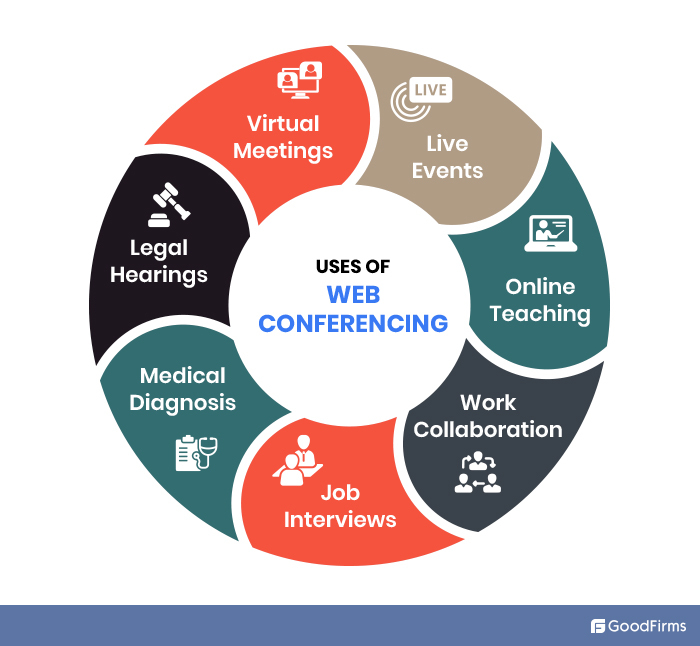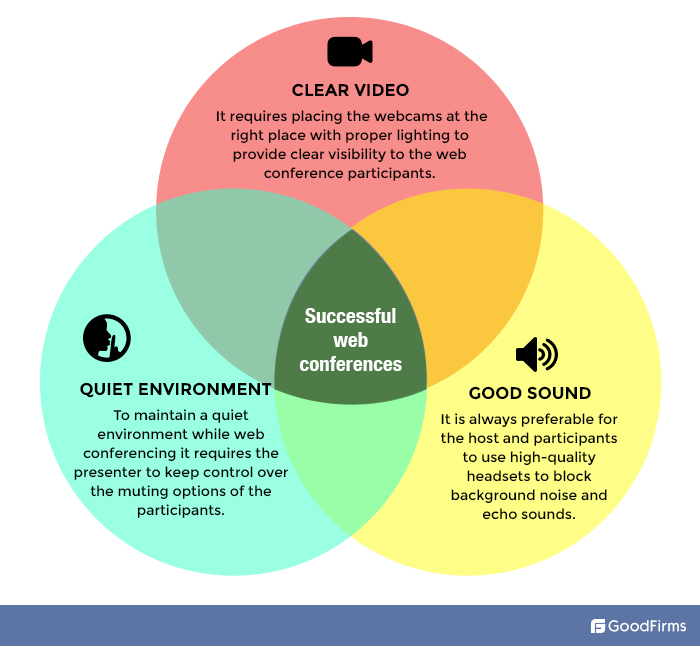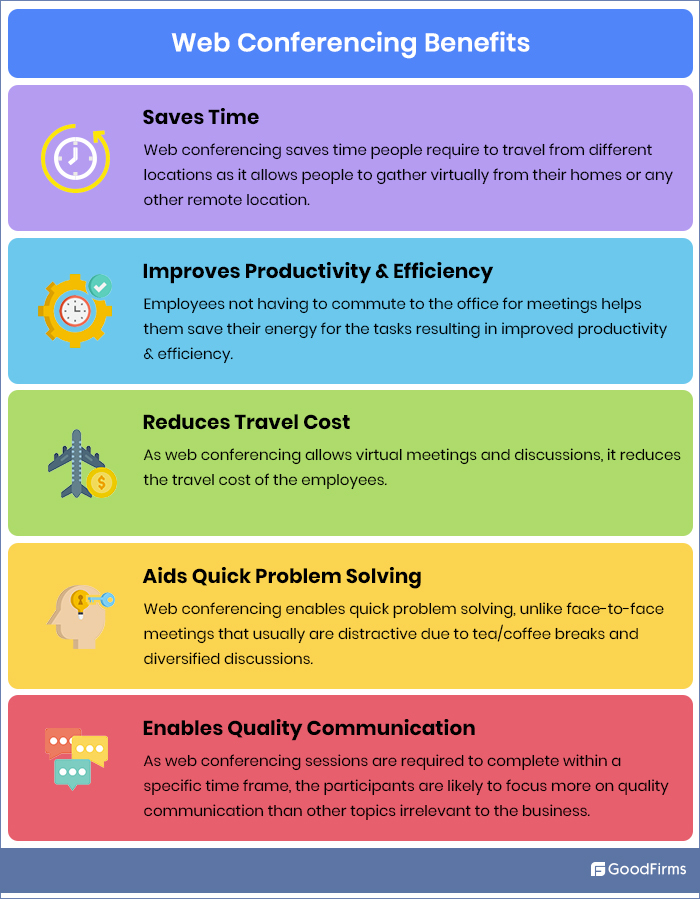Whether it is about conducting webinars, client consultations, tutorials, or hosting product demos, web conferencing tools have a significant role in making every virtual meeting a successful one. Additionally, the Covid-19 pandemic suddenly transformed face-to-face meetings into virtual meetings. The rapid spread of Coronavirus and stay-at-home mandates upsurged virtual meetings and online learning concepts resulting in the increased use of web conferencing solutions like Zoom, Google Meet™, and Microsoft Teams.
Web conferencing was not new for globally spread enterprises, even in the pre-pandemic era. But, after this pandemic struck, the use of web conferencing software soared exponentially because the employees started working from their homes and could not gather in the offices for even crucial decision-making tasks.
One of the most famous web conferencing applications - Zoom, had 10 million daily users in December 2019, which rose to around 300 million by April 2020.

Furthermore, as per Gartner's prediction, only 25% of personal meetings would be conducted by 2024; the rest would be virtual meetings through web conferencing tools.

This is because web conferencing empowers hybrid work models, enables businesses to expand globally without investing in office spaces, and saves traveling costs.
This article covers the below topics in support of the fact that - web conferencing is here to stay and rule.
Table of Content:
- What is Web Conferencing?
- How does Web Conferencing Work?
- Popular Uses of Web Conferencing
- Difference Between Web Conferencing and Video Conferencing
- Important Features to Consider in a Web Conferencing Tool
- What Makes a Successful Web Conference?
- The Concept of End-to-End Encryption in Context With Web Conferences?
- Web Conferencing Security Best Practices
- Benefits of Using Web Conferencing Platform to Conduct Meetings
- The Future Role of Web Conferencing: Will Virtual Meetings Replace Face-to-Face Meetings?
What is Web Conferencing?
Web conferencing is an act of conducting real-time online meetings that can include audio, video, and text chat using web/mobile devices and the internet. The participants of this virtual meeting log into the web conference application from their computer devices to connect and interact with each other. The web conferencing tools also facilitate participants to share screens, view PowerPoint presentations, and display whiteboard sketches for effective discussions and better understanding.

By using a web conferencing tool along with a computer device and internet connection, you can conduct virtual meetings that involve multiple participants physically present in different geographical locations. The participants can see and interact with each other on a real-time basis. Web conferencing has become very popular these days because of work from home and hybrid work environments being adopted by most organizations. Web conferencing has bridged the gap between the employees working from different geographical locations, eliminated communication barriers, and made decision-making easier for companies globally.
How does Web Conferencing Work?
Web conferencing can be scheduled and organized using a web conferencing software or application that is installed in an internet-enabled computer device, be it a laptop, mobile phone, or a tab with a webcam and microphone. To understand how web conferencing works, it becomes imperative to know its different components that enable capturing and transmitting audio sounds and video footage.
Core Components of Web Conferencing

Steps to Follow While Conducting a Web Conferencing Session
Scheduling - When you schedule a meeting, the web conferencing application automatically generates a link that can be sent to the participants. The participants can join the meeting on the specified date and time using the meeting ID and password generated along with the link.
Joining - The participants who need to join are required to click on the meeting link or enter the meeting id and password on the home screen of the web conference application.
Screen Sharing - After joining the meeting, you can share your screen for showcasing your presentation.
Whiteboard - The web conferencing system also allows you to select a whiteboard that enables all the participants to note down their views for better collaboration.
Text Chat - The participants can also textually communicate with each other using the instant messaging feature of the web conferencing software.
Popular Uses of Web Conferencing
Being extremely convenient and cost-effective; web conferencing tools are being applied to many business areas. Some of them are explained below -

Virtual Meetings
Whether for business or personal purposes, web conferencing plays a vital role in setting up group video and audio conversations. A group of people physically located at different places can virtually gather together using web conferencing tools. Discussing project details becomes convenient as web conferencing allows file sharing and whiteboarding.
Live Events
Scheduling, and streaming live events to a larger online audience was a bit difficult till Web conferencing tools were designed. Attending an event through web conferencing became quite popular after the outbreak of Covid-19 when people were unable to travel and required to maintain social distance. Similarly, business events were being conducted online, and seminars became webinars because of the pandemic spread and stay-at-home mandates.
Online Teaching
Web conferencing has made it simple for teachers to interact with their students based at different geographical locations. Online learning courses and hybrid teaching methods are being introduced by even the top-notch universities these days because it has contributed a lot to saving the traveling and boarding charges of the students. Web conferencing technology enables the students to learn from the teachers of their choice and makes long-distance education programs successful.
Work Collaboration
In this era of remote working culture and hybrid working environments, the employees working from different physical locations are required to collaborate with each other in terms of sharing files, discussing project specifications, and more. It often requires employees to gather together at one place for critical decision-making and addressing some crucial issues. In that case, web conferencing can bring the employees together and enable them to meet virtually, ultimately helping them collaborate effectively.
Job Interviews
The most critical task for a company while globally expanding is to hire local staff. Moving to different locations to interview and hire the right talent is difficult and turns out to be expensive. In that case, conducting interviews using web conferencing tools can be a great way to meet the candidates face-to-face, as it becomes easy to judge and know their talents, making the recruitment process easy.
Medical Diagnosis
In certain situations, patients cannot move out of their homes for medical diagnosis or treatment due to their disability or the risk of getting infected. For that purpose, web conference technology has helped doctors and physicians examine their patients remotely, prescribe medicines, and suggest suitable treatments.
Legal Hearings
Lawyers and courtrooms are using web conferencing technology to question the accused and victims who cannot remain present physically due to their medical conditions or any other critical reason. Using web conferencing has quickened the decision-making process for many legal entities and courtrooms as it has become easy to acquire the testimony of even those people who do not wish to or are not able to appear face-to-face.
Difference Between Web Conferencing and Video Conferencing
Web conferencing and video conferencing - these two terms are often confused with each other as both are related to audio and visual communication. The fundamental differences between these two are -

Important Features to Consider in a Web Conferencing Tool
Easy Scheduling & Simple Invites
Customers and team members often come up with urgent discussion issues. In that case, the web conferencing tool should provide you with an easy way to schedule a virtual meeting or simply enter a virtual meet by clicking a link.
Mobility
The web conferencing tool should allow the users to host or participate in a virtual environment from any place at any time. Thus, the web conferencing platform should be platform and device-friendly, allowing the users to interact regardless of where they are and whether they are using a desktop, laptop, or mobile device.
Screen Sharing
Sharing screens while web conferencing makes presentations better and more comprehensive. It becomes easy for the host to make the participants understand the concepts, teach them the new software, review specifications and designs even though they are physically apart from each other.
Real-Time Chat
When a speaker is delivering a presentation or a speech during a web conference, it can become quite disturbing if the participants start questioning. For that purpose, there is an option in web conferencing applications that allow participants to text chat and inform the presenter about their queries. It also becomes easy for the meeting host to interact with the participants without getting distracted.
Recording
If a web conferencing tool records the entire virtual meeting session, it becomes easy for the participants who cannot attend. Also, this recording helps the students revise the course that has already been taught by the teacher virtually and share that video with other students who were unable to attend.
Integrations
A web conference tool that allows Google Calendar integration makes it easy to schedule meetings and send automated reminders to the participants. Also, integrating with other software that you frequently use, like Microsoft 365, Salesforce, etc., helps you easily share the details with the participants and make your presentations successful.
Audio and Video Quality
The web conferencing tools come with in-built audio and video features. Ensuring that your web conferencing tool enables you to conduct virtual meetings with crystal clear audio and video is required to make your web conferencing experience a successful one.
Security
The web conferencing tool you choose should allow you to keep your virtual meeting password-protected, limit screen sharing, lock meetings, remove unwanted guests, two-factor authentication, and end-to-end encryption. This helps you ensure that the data shared during the meeting is secure and the participants' information is safe.
What Makes a Successful Web Conference?

Besides the above requirements, data security plays a major role in the success of a web conference. A lot of information is prone to risk over a web conference like trade secrets, new product specifications, participants' details, and much more. Rivals and hackers are always around to steal this type of information, which can be a significant threat to a business.
Enabling end-to-end encryption for web conferences can help in overcoming this challenge.
The Concept of End-to-End Encryption in Context With Web Conferences?
End-to-end encryption is a method of applying encryption to the data from senders' devices to the recipients' devices where those messages can be decrypted. It is similar to an email that only the recipient can access after proving their authenticity. No other third party can access the encrypted data besides the sender and the recipient keeping it highly secure and safe from malicious hacking activities and viruses. Thus, the data cannot be stolen anywhere if an end-to-end encryption method is applied.
An end-to-end encrypted web conference enables -
- The conversation to be private between the host and the participants
- Data encryption and decryption at each participant's endpoint regardless of the platforms and devices they are using - laptop, smartphone, or iPad/tablet.
- Encryption of all the data, including audio, video, chat, and annotations
Besides data encryption, below are some practices to be followed to ensure secure web conferencing -
Web Conferencing Security Best Practices
Update Systems Regularly
Outdated systems are more prone to cyber-attacks. Thus, it is imperative to update the systems used for web conferencing regularly because a lot of information is at risk of being stolen or sabotaged.
Define Usage Policies
There should be specific usage policies defined for the participants. The participants' systems should not contain any type of malicious software or files. The participants should watch their systems and follow usage guidelines for secure web conferencing.
Block Random Participants
Participating in web conferences requires a meeting ID and password, but the participants are often allowed freely through the meeting link itself. In that case, many unknown participants may barge into the conference room, which can risk the security of the conversations. In such situations, the host should have the right to remove the suspicious participants to carry out secure web conferencing sessions.
Integrate Two-Factor Authentication
The web conference meeting id and password get hacked in certain situations, creating havoc among the participants. In that case, integrating two-factor authentication helps in ensuring that only authorized participants are allowed to enter the virtual meeting sessions. For instance, a web conferencing platform might ask a user to receive an OTP via SMS, and then upon confirming that OTP the user is allowed to enter the web conference. This way, the hackers might have a hard time accessing the information shared in a web conference.
Benefits of Using Web Conferencing Platform to Conduct Meetings
The covid-19 pandemic has suddenly increased the demand for the tools that cater to the work-from-home and hybrid working environments - web conferencing platform is one of those. With so many businesses and employees working therein using web conferencing tools to meet and collaborate, let's have a look at some of its major advantages.

The Future Role of Web Conferencing: Will Virtual Meetings Replace Face-to-Face Meetings?
Web conferencing is not a new concept for businesses as it has been here since 1999. But, during that era of dial-up internet connections, web conferencing was not a quite practical idea for many. Now in this age of 5G network businesses and the benefits of web conferencing being so prominent, enterprises have realized that it is the most convenient option to conduct meetings. Moreover, the situation demands it.
So, now web conferencing is in high demand. But, what about the future? Will web conferencing replace the traditional face-to-face meetings even after getting rid of this pandemic forever?
In the current scenario, many businesses have already adopted the hybrid work environment for better employee experience and retain top talent. So now people want to work and attend meetings from the place of their choice. Moreover, there are so many technological advancements taking place that have already improved the virtual meeting experience for the participants to a great extent.
Web conferencing has enabled businesses to be more practical when it comes to important decision-making and critical negotiations. Now meeting in person is considered an old-fashioned way that falsely claims to build relationships between people. On the other hand, virtual meetings have proven to eliminate the hesitation and shyness of the attendees and help them come up with their ideas more confidently than in-person meetings.
As per a recent report, the global web conferencing market size was valued at $3.62 Billion in 2019 & is projected to reach $10.46 Billion by 2027, at a CAGR of 14.3% during the forecast period.

Source: (fortunebusinessinsights.com)
The reason behind this growth in web conferencing market size is the rise in remote working. Businesses have now discovered that they can acquire the same level of productivity and efficiency as they can from in-office employees. Thus, several companies have implemented a hybrid work culture within their organizations wherein many employees have been permanently allowed to work from home.
To empower these flexible work environments, robust web conferencing systems are required to keep the team members connected and eliminate the problems arising from communication gaps. Web conferencing brings people together, making face-to-face interactions happen virtually without commuting anywhere.

(Source: CNBC)
The Key Takeaways
Remote working is here to stay as it is beneficial for employees and companies alike. However, within this remote working culture, web conferencing tools become highly significant to empower the workforce to stay connected with each other, collaborate in a better way. Providing the right tools to the workforce gives the companies the advantage over their competitors and helps them set new benchmarks and achieve their goals. If you have still not equipped your employees with the best web conferencing software, the time is now to do that because that would help you balance your in-office and remote workforces and progress in this extremely competitive business environment.



